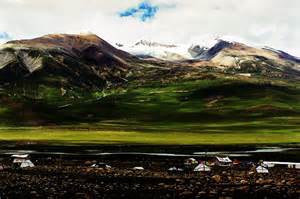When you hear the word "mutation," you may think of something destructive, or of Marvel's X-Men. But some mutations—which are just differences in DNA—can be historic. Take, for example, a genetic sequence found in the vast majority of people from Tibet.
當(dāng)你聽(tīng)到“突變”這個(gè)詞的時(shí)候,你可能會(huì)聯(lián)想到某些具有破壞性的東西,或漫威漫畫(huà)公司出品的X戰(zhàn)警。但有些突變,如基因差異,卻是有歷史意義的。下面就拿一組基因序列來(lái)說(shuō)吧,該組基因序列存在于絕大多數(shù)的西藏居民中。
Millions of Tibetans spend their days at average elevations of nearly 15,000 feet—that's more than half the height of Mount Everest. Up there, the air is thin—with 40 percent less oxygen than at sea level. That lack of O2 would leave most Westerners struggling for breath, but Tibetans seem to breathe easy.
數(shù)以百萬(wàn)計(jì)的藏族人居住在平均海拔近15,000英尺的地方——這可是半個(gè)珠穆朗瑪峰的高度。那兒,空氣稀薄——氧含量比水平面低40%。由于缺乏氧氣,大多數(shù)來(lái)到此地的西方人都會(huì)感到呼吸困難。但藏族人卻不會(huì)。

To find out how these highlanders cope, researchers compared the DNA of 90 Tibetans to that of people who are not altitude adapted. And they discovered a single change that prevents Tibetans' blood from becoming dangerously clogged with red blood cells—a response that can be deadly for non-native mountaineers. The finding is described in the journal Nature Genetics.
為找出其中原因,研究人員將90名藏族居民的DNA與那些不適合在當(dāng)?shù)鼐幼〉娜说腄NA進(jìn)行比較。他們發(fā)現(xiàn):藏族居民DNA里存在一個(gè)突變,該突變能防止藏族居民的血液過(guò)分充滿血細(xì)胞——該反應(yīng)對(duì)非當(dāng)?shù)鼐用竦牡巧秸邅?lái)說(shuō)是致命的。該項(xiàng)研究發(fā)表在《自然遺傳》雜志上。
This mutation appears to have originated just 8,000 years ago. But it's so advantageous that today nearly 90 percent of Tibetans have it. While it's virtually absent in even closely related lowland neighbors.
該突變起源于8,000年前。如今,90%的藏族居民都有,這對(duì)他們來(lái)說(shuō)真是太有利了。但那些居住在低地的、甚至與高地居民有密切血緣關(guān)系的鄰居卻幾乎沒(méi)有。
The finding demonstrates that a really useful mutation will always rise to the top.
該研究結(jié)果表明有利的突變總是能備受矚目。











